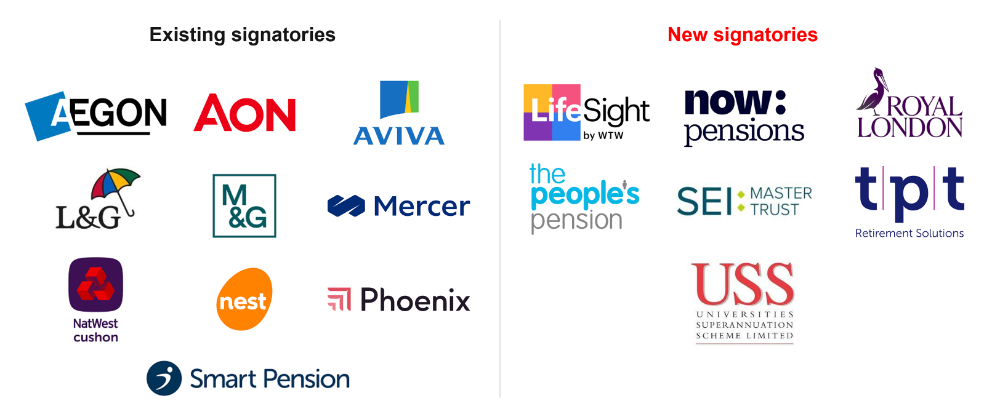- in United States
The Government's pursuit of increasing Defined Contribution (DC) pension investment into private capital markets has stepped up a gear. On Tuesday 13 May 2025 a voluntary industry-led initiative, coined the Mansion House Accord, was published. This initiative brings together 17 of the largest pension funds and sets out their commitment to increase investment in private markets. The agreement builds on the 2023 Mansion House Compact.
Under the new Mansion House Accord, 17 signatories have committed to invest at least 10% of their main default funds in private markets by 2030, half of which should be invested in the UK. It is reported this will mobilise £50bn of UK pension fund capital into a wider pool of private assets which includes property, infrastructure, private credit, private equity, and venture capital over the next five years.
Although the old Mansion House Compact agreement was seen as ambitious, the scale of these targets is another level. In comparison, the early adopters of the old agreement had only committed to 5% in unlisted equities and there was no domestic allocation. The new agreement shows a significant expansion in ambition in terms of scale and scope.
What private capital assets are included in the target?
Assets include directly held, or investment through unlisted funds in property, infrastructure, private credit, private equity, and venture capital. AIM and Aquis Growth Market shares will also count towards the target.
What is the definition of UK assets?
For equity-based assets, investments in UK registered private companies or partnerships will meet the definition of UK assets. Infrastructure and property-based assets will qualify if the asset is located in the UK. For private debt/credit assets, the UK definition will be met if the borrowers are located in the UK.
What conditions are attached to the agreement?
Despite some speculation, the Government has resisted attempts to make the targets mandatory. However, in the government's press release accompanying the agreement, the Government states that they will monitor progress and reserve powers to bind pension funds to certain asset allocations if they do not see sufficient progress. The nature of the power has not been revealed however, it could include an ability for the Government to name and shame pension providers that do not meet the target. This reserve power is anticipated to encourage the wider pensions market to share the Mansion House Accord ambitions and further boost investment into private capital markets. More detail on what the backstop entails is expected in the upcoming final report of the Pensions Investment Review due to be published in the coming weeks and associated legislation will feature in the Pension Schemes Bill due to be published this summer.
As part of the Mansion House Accord agreement, the pension industry have also set their own boundaries and expectations. Fiduciary duties and the Consumer Duty have understandably been non-negotiable points meaning trustees will continue to act in the best interests of their beneficiaries over and above these wider goals. The industry has also challenged the government to facilitate a pipeline of UK investment opportunities.
The Government, pension industry and wider private capital market will also need to navigate the tensions between cost and value, which to date, has prevented more investment in productive assets where cost has been the driving force. The Value for Money framework will be another important milestone in driving pension reform.
Who are the signatories?
The 17 signatories are:

What does this mean for the private capital industry?
The drive to encourage investment in a wide range of assets will be welcomed by private capital managers and serves as a reminder to increase their engagement with the pensions industry. Private capital managers will want to monitor these developments and ensure that the Government unlocks other regulatory barriers that have prevented investment at scale in private capital.
As a result of these new ambitions, private capital managers are likely to need to adapt:
- what investments their funds make;
- how their funds make investments;
- their fund structures; and
- how they organises themselves and their economics.
Investment policy and strategy
Private capital managers may seek to review their investment policies and consider whether a certain proportion of the fund (measured by reference to total fund commitments, invested capital or the capital provided by pension fund) is invested in UK investments.
Fund sponsors whose investment policy can encapsulate favoured sectors (investments that support UK growth sectors, including clean energy infrastructure and innovative small businesses which were trailed by the government although not formally part of the agreement) may also find themselves in a better position to secure capital from these new groups.
Managers may also want to consider the key risks DC default pension schemes face when investing in illiquid assets. Although, by and large, liquidity management will be managed at the scheme level with a diversified portfolio, private capital managers may need to consider liquidity access requirements and provide more details about the liquidity profile of the fund vehicle and underlying investments.
Holding and making of investments
Fund sponsors may also come under pressure to change the way in which they make, operate and exit, their investments.
- On acquisition and exit, fund sponsors can expect more scrutiny of the nature of the persons they are investing alongside and selling to, as reputational issues become more important.
- Pension fund investors may become more active in trying to impose specific leverage limits. Fund sponsors may be able to manage this, including by offering parallel leveraged and non-leveraged vehicles inside one fund programme, but there is greater difficulty if a pension fund imposes limits on leverage used at the level of portfolio companies.
- These sorts of investors would typically prefer plain vanilla holding structures, perhaps steering sponsors to make use of the UK's qualifying asset holding company regime ahead of holding structures which utilise offshore companies.
- Fund sponsors may find themselves having to report more extensively and in a specific way to enable pension funds to report on their progress. This will necessitate processes, reporting systems and controls which are more onerous for smaller portfolio companies to comply with.
Fund structures
Many, but not all, pension funds access their investments via unit-linked life policies. This restricts the types of funds they can access to those which the insurer issuing the life policy is able to categorise as so-called "permitted links" for regulatory purposes. Traditional private market fund structures are capable of being categorised as "permitted links" in some circumstances but pension funds may have a preference for sponsors to offer their strategies through fund structures which are more straight forward for insurers to classify, such as the Long-Term Asset Fund.
Economics and internal organisation
UK DC pension schemes are subject to a fee rate cap of 75 basis points (the "charge cap"), and many default schemes operate below this charge cap. The conventional wisdom has always been that such schemes will struggle to reconcile the charge cap with the management fee levels charged by private capital funds. However, the reality is that given the preponderance of lower charging passive funds in some of these schemes, trustees typically have more wiggle room to allocate to more expensive private fund investments, especially if they can also negotiate headline fee discounts for making earlier and larger commitments to fundraisings.
Performance fees have also been excluded from the charge cap since April 2023, which gives managers more freedom in how they structure compensation. There is undoubtedly still some work to be done by fund sponsors to convince pension fund trustees that private fund investments represent real value on a risk-adjusted and liquidity-adjusted basis, but the Mansion House Accord further demonstrates that the larger pension fund providers are coming around to that position. The Value for Money framework due in the coming weeks will provide more clarity on how the government intends to manage this.
Pension funds may also have obligations to invest only in structures which are UK domiciled. This may extend not only to the fund vehicle itself, but to elements of the sponsor structure. Fund sponsors who, for a variety of reasons, operate their business or hold carried interest through offshore entities, may be asked to simplify these arrangements before their funds accept pension commitments. Alternatively, bespoke structures may need to be created for pension investment vehicles separate to the main fund vehicle, with their own carried interest and co-investment entities.
Next steps
The pension industry has managed to stave off binding investment thresholds for now, however the full details of the government's reserve powers are anticipated. More details are expected in the final report of the Pensions Investment Review due in the coming weeks and legislation can be expected in the summer.
The pace of legislative activity in the pensions market is set to continue during 2025. By way of recap, we are expecting:
- Pensions Investment Review – final report. This is due to be published in Spring 2025. This will include details of the government's reserve powers on asset allocation amongst other measures.
- Response to DB scheme and Local Government Pension Scheme (LGPS) consultations. These are due to be published in Spring 2025 and will provide more details on how DB schemes can invest their surplus funds and how LGPSs are expected to scale and consolidate their assets.
- Pension Schemes Bill. This is due to be published before summer recess (22 July 2025). It is anticipated to include the measures outlined above as well as the Value for Money framework and other measures designed to consolidate and scale aspects of the DC and DB market.
The content of this article is intended to provide a general guide to the subject matter. Specialist advice should be sought about your specific circumstances.




